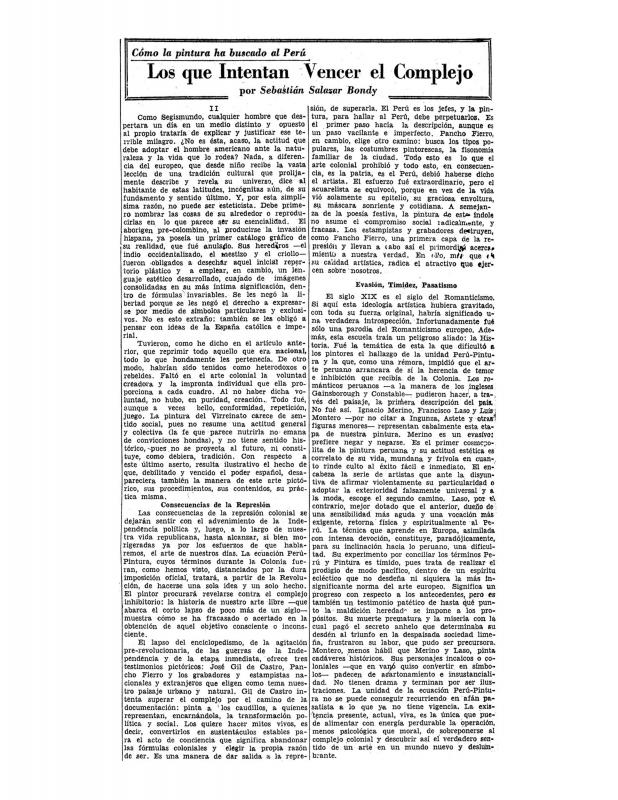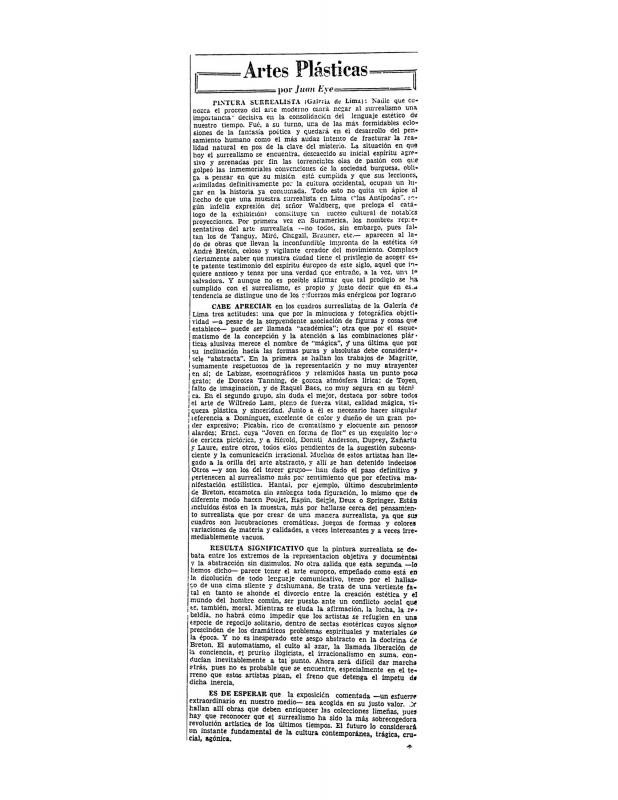This article—the third in a series—brings to a close one of the most important debates between the faction of Peruvian modernists known as “artepuristas” and supporters of “socially committed art.” Here, architect Luis Miró Quesada Garland (1914–94) discusses the problem of nationalism in painting.
In the modernist debates over this issue—debates that began in June 1951 with statements by painter Fernando de Szyszlo (b. 1925) [see in the ICAA digital archive “Dice Fernando Syszlo que no hay pintores en el Perú ni América: el joven pintor peruano declara sentir su pintura y la de los demás pero no puede explicarla” (doc. no. 1137793)]—critic Samuel Pérez Barreto (1921–2003) defended earthly abstraction as the only possible means to devise art both “Peruvian” and modern [see his texts “Pintura: la guerra de los pintores: plumas por pinceles” (doc. no. 1137839), “Arte: la guerra de los pintores” (doc. no. 1137856), and “Polémica: ‘polémica Espacio’” (doc. no. 1137916)]. Despite Pérez Barreto’s position, the terms of the debate that ensued over the course of the fifties pitted programmatic and figurative nationalism against an abstract language committed solely to art (the position upheld by Miró Quesada Garland in this text).
Writer Sebastián Salazar Bondy (1924–65) even projected the tensions between “the visual arts” and “nationalism” onto the past. He gave a lecture entitled “Cómo la pintura ha buscado al Perú” that constructed a systematic history on the basis of the “Peru-painting” equation (Lima, September 12, 1955). The lecture was later published in three parts: [“El arte colonial entendido como represión” (doc. no. 1138058), “Los que intentan vencer el complejo” (doc. no. 1138075), and “Hallazgo de la realidad perdida: siglo XX” (doc. no. 1138092)]. It suggests Salazar Bondy’s negative opinions of Peruvian colonial art, opinions he would later voice in no uncertain terms in his Lima la horrible (1964)—a book pivotal to the sixties generation. This column by Miró Quesada Garland—a major framer of Peruvian artistic and architectural modernism—is one of the most acute questionings of the nationalist discourse. In it, he makes ironic reference to the “Peru-painting” equation as a contradictory comparison of terms political and artistic. Salazar Bondy’s response led to an extensive exchange of articles between the two men [for additional information, see “En blanca y negra” (doc. no. 1138753) and (doc. no. 1138718)].
[For further reading, see other texts by Salazar Bondy pertinent to the debate on nationalism, such as “En torno al desarraigo” (doc. no. 1138565), “Artes plásticas” (doc. no. 1138582), and “Punto final” (doc. no. 1138231). On the other side of the debate, see the column written by Miró Quesada Garland, the primary framer of modern art in Peru, entitled “En blanca y negra” (doc. no. 1138599), (doc. no. 1138620), and (doc. no. 1138248)].















